There’s no denying the value of a strong commercial roof. It’s your main defense against the elements and keeps your internal investments safe from damage.
But for all the thought of how a roof protects what’s under it, many building owners lose sight of protecting the roof itself. Just because roofing materials are built to last decades doesn’t mean you can leave them neglected.
The effects of damage to neglected commercial roofs can grow exponentially. One small crack will grow over time until what would have been a simple repair becomes a full-blown roof replacement.
It all comes down to having a plan in place for regular roof maintenance. When you plan for preventive maintenance, you can vastly improve the cost efficiency of your roof in the long term.
5 Signs of Roof Damage to Stay Ahead
1. Ponding
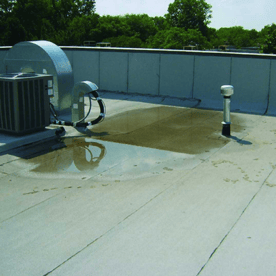
Having some water on the roof after a storm is perfectly normal. But when you start to see ponding for long periods of time, you know it’s time to take action. Ignoring standing water on your roof can cause leaks, which can cause persistent damage to any type of roof. And as water continues to build up, you can create weight issues that will eventually cause far more damage than dripping water.
When your entire roof is dry, but you see a pond of water that won’t go away, make a call to repair before the damage starts impacting the building’s interior.
2. Bubbles
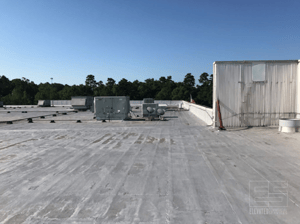
When you’re self-inspecting the roof, you might see air bubbles across the roof cover. These bubbles occur when moisture is trapped under the membrane. While the clear consequence can be leaking, bubbles also reduce your roof’s effectiveness against high winds and can reduce the overall lifespan of the roofing materials.
It’s important to spot bubbling problems early. If you get to the roof and the bubbles are widespread, the damage might be too extensive.
3. Flashing Damage
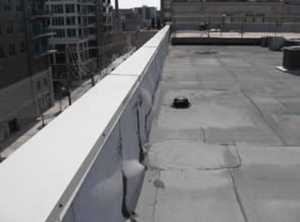
The metal flashing at the perimeter of your commercial roof (and around RTUs) seals edges from letter water under the membrane. However, when the flashing is damaged, the roof can suffer from mold and leaks as well as reduced protection against extreme weather.
4. Cracks in the Roof Membrane
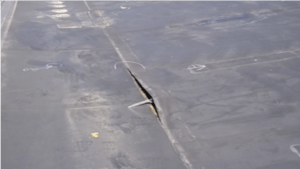
Perhaps the most basic form of rooftop damage comes in the form of cracks in the roof cover/membrane. As the membrane deteriorates, cracks, and tears, water can seep in and cause lasting damage. However, spotting cracks isn’t always easy.
Especially after hail storms and any extreme weather that causes tree damage, it’s important to inspect the roof for any tears.
5. Penetration from Rooftop Units
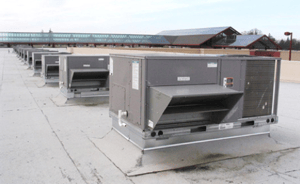
Sometimes, rooftop unit installation makes membrane penetration necessary. But when penetration is mishandled, it can result in cracks and tears around the units.
Specifically, AC units, walkways, cables, vents, and electrical boxes on your roof are all sources of potential damage. The key is to have rooftop support systems in place that effectively minimize damage and increase the longevity of the roof.
If your support systems aren’t installed properly (or you don’t have the right support systems at all), you can wind up with high-price repair costs or unexpected roof replacements.
These are just a few signs of damage on your roof that prove it’s time to get repairs done before it’s too late. However, there are plenty of other considerations for proper roof inspections—gutters, loose debris, rooftop vents, pre-existing vulnerabilities, severe weather impact, etc.
Following best practices for a preventive maintenance plan is essential to long-term efficiency of your commercial roof.
Best Practices for Preventive Roof Maintenance
Taking an active role in preventive roof maintenance is great. However, the reality is that you’ll need a professional to come in and do a thorough check for problems. The questions is, how often does that need to happen?
A good rule of thumb is to have a professional roof inspection twice a year. One inspection should be just after the winter months and another just before the fall. That way, you can ensure you’re prepared for the rougher weather.
In between professional inspections, here are a few best practices for self-checking your roof:
- Be mindful of the roof’s slope, material, and access. Sometimes it’s not safe to inspect the roof without a professional.
- Log all activity on the rooftop because any non-professional work can inadvertently cause damage.
- Inspect drains and gutters to clear blockages.
- Look for any water buildup or staining around flashing or RTU penetrations.
- Inspect vents for proper seal.
- Clear any loose debris from the rooftop.
- Always check for damage after a particularly heavy storm.
While building owners can save some money in the short term through self-inspection, the costs of overlooking problems can be significant. Miss one crack and you could be looking at a full replacement in the future.
Want to learn more? Contact us today. To learn more about PHP or to schedule a free rooftop support evaluation. Visit PHP online and submit a free evaluation request form or call PHP at 1-800-797-6585.




